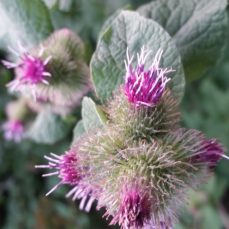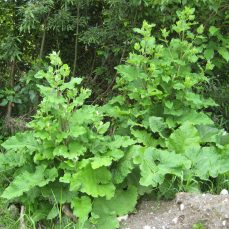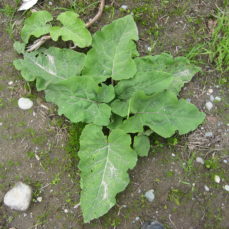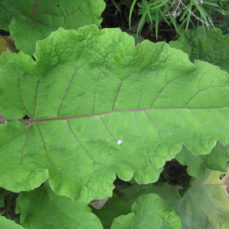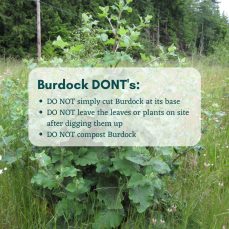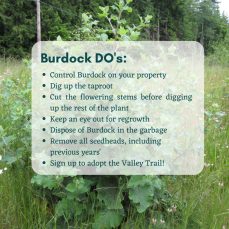Common Burdock
Arctium minus
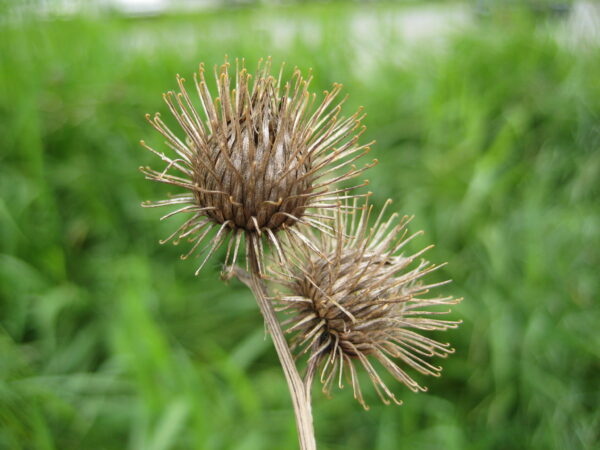
Vectors of spread
Synonyms
- Beggar’s Buttons
- Lesser Burdock
- Wild rhubarb
- Cockle button
- Hurr-burr
- Wild Burdock
- Lappa minor
- Bardane (in French)
ID Characteristics
General: Common Burdock is a biennial herb that grows 0.5-3 m tall and produces burs with hooked bristles that can cling onto clothing, equipment, and animals. These burs were actually the inspiration for Velcro!
Flowers: Flowers mature into brown, circular-shaped burs that cling to everything. Before this stage, the flowers are purple on green circular-shaped burs that are approximately 2.5 cm in diameter, with hooked green bristles.
Stem: The stem is upright, grooved, and has a reddish tinge towards the base of the plant. After the rosette year, Common Burdock grows an upright, grooved, and highly branched flower-bearing stem up to 3 m tall.
Leaves: In the first year, the leaves form a rosette. The green leaves are large, heart-shaped and hairy underneath, with wavy edges and a slight upwards curl. They are sometimes confused with rhubarb.
Roots: Common Burdock has a thick and fleshy taproot.
Seeds: Common Burdock seeds are about 6 mm long, mottled and ridged.
Similar Species

No machine-readable author provided. Folini assumed, https://commons.wikimedia.org/w/index.php?curid=688166
Native
Cocklebur (Xanthium strumarium): Has smaller, spiny leaves.
Non-native (invasive)
 Great Burdock (Arctium lappa): Has larger flowers than Common Burdock, with solid lower leaf stalks.
Great Burdock (Arctium lappa): Has larger flowers than Common Burdock, with solid lower leaf stalks.
Curly Dock (Rumex crispus L.): Has smaller leaves and it’s leaves are not as wavy at the edges compared to Common Burdock. Curly Dock also does not produce burs.
Non-native (exotic)
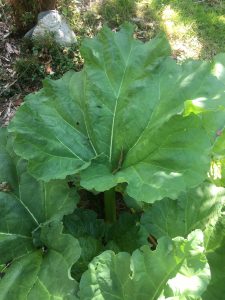
Rhubarb (Rheum rhabarbarum): Unlike Common Burdock, underside of leaves do not have woolly fuzz, and the stems are not hollow.
Report
Please report any sighting of Common Burdock by clicking here.
Habitat and Origin
Common Burdock was unintentionally introduced from Europe to North America. The first sighting of this species in North America was reported in 1638.
Common Burdock thrives in moist, fertile, and nitrogen-rich soils of disturbed areas such as roads, ditches, and riparian areas.
Current Distribution

Propagation & Vectors of Spread
Common Burdock propagates by seed and can produce 6,000-16,000 seeds per plant in the form of burs, during its typical life span of four years. Seeds are shed throughout the fall, winter, and following spring, while the majority of seeds germinate in early spring. Common Burdock spreads by its clinging and prickly burs, which attach themselves to animals, clothing, and equipment. The burs can remain on animals for several weeks and be carried more than 10 kilometres.
Common Burdock is generally considered a biennial plant: it forms a rosette of leaves in the first year, and flowers in its second year before dying off. However, observations in the Whistler area show that some plants are adopting a perennial life cycle.
Ecological and Economic Impacts
Ecological:
- Burdock’s large leaves can outshade and outcompete native plants, leading to biodiversity loss.
- If left to decompose on site, Burdock’s leaves display allelopathic properties and prevent native species from germinating. In other words, chemicals released as Burdock grows or decomposes inhibit the growth of most other plants.
- There have been occasional incidences where birds and bats have become entangled in the burs and died.
- Common Burdock creates suitable environments for other invasive species in the same native range, such as Bitter Dock and black aphids.
Economic:
- Common Burdock hosts powdery mildew and root rot, which can spread to farmer’s crops and reduce crop yield.
- Burdock taints dairy products when grazed by livestock.
- Burs can become tangled in horses’ manes and sheep’s wool, damaging their quality and reducing their value.
- Common Burdock crowds out forage grasses in pastures.
What Can I Do?
Common Burdock is found in the Sea to Sky region and its distribution is beyond landscape-level control. When Common Burdock is present at high-priority locations and negatively impacting them, their control is considered a high priority.
Otherwise, the goal is to prevent it from spreading to new (uninfested) areas, and to control it where possible to limit its impact on biodiversity.
Learn to identify Common Burdock: use the images presented in this profile page to learn how to identify Common Burdock.
What to do if you spot it: You can report any Common Burdock sighting by clicking here.
DO:
- Regularly monitor properties for weed infestations.
- Ensure soil and gravel are uncontaminated before transport.
- Maintain and establish healthy native plant communities to help resist invasion.
- Remove flowering heads and burs from personal gear, clothing, pets, vehicles, and equipment.
- Ensure that all flowering heads and buds are bagged and disposed of in the household/general waste stream at the landfill.
DO NOT:
- Unload, park or store equipment or vehicles in infested areas; remove plant material from any equipment, vehicles or clothing used in such areas and wash equipment and vehicles at designated cleaning sites before leaving infested areas.
- Compost any flowering heads or burs. Instead, dispose of Common Burdock in the general/household waste stream at the landfill as the seeds will be able to persist the composting process.
- Move soil, gravel, or fill that has been contaminated with Common Burdock.
Control
Mechanical
- While sources typically recommend severing the taproot below the root crown to kill the plant at the first year stage (rosette), this is rarely done properly, leading to greatly diminished efficiency with this approach.
- A better approach is to remove the taproot in its entirety by digging it up.
- Cutting above-ground vegetation when the plant is in its second year of growth can be a stopgap control method, but carefully consider the timing of mechanical control efforts: cutting Burdock after seedheads develop compounds the problem and risks spreading the seeds. Burdock also tends to branch out when the leaves are cut but the taproot is not removed.
- Remove all plant material from the site to avoid Burdock’s allelopathic effects.
- Lastly, remove all seedheads, including previous years’, and dispose of in sealed garbage bags with household waste.
Chemical
- Foliar herbicides are rarely used on Common Burdock because of the effectiveness of repeated mechanical removal.
- Burdock can be controlled with 2,4-D, picloram, dicamba, or glyphosate, but note that picloram is not suitable in wet, coastal soils.
- Herbicides are most effective when applied to first-year rosettes.
- All herbicide applications should be monitored over successive years as follow-up treatments may be required, and to evaluate the efficacy of the chemical control method.
- We recommend that any herbicide application is carried out by a person holding a valid BC Pesticide Applicator Certificate. Before selecting and applying herbicides, you must review and follow herbicide labels and application rates; municipal, regional, provincial and federal laws and regulations; species-specific treatment recommendations, and site-specific goals and objectives.
Biological Control
There is no official biocontrol for Common Burdock in BC. However, a seedhead-feeding moth (Metzneria lappella), which is among the 13 insects that are known to attack Common Burdock, is present in BC. It arrived here adventitiously from other parts of North America. This moth greatly reduces the number of viable seeds in a plant.
Integrated Control
Integrated management efforts must include the elimination of seed production and the depletion of the seed bank. Regardless of the control method(s) used, it is paramount to also remove all seedheads; note that it will likely take several years to exhaust the seed bank.
References
- Alberta Invasive Species Council, Common Burdock Factsheet, https://secureservercdn.net/198.71.233.231/yjc.cc8.myftpupload.com/wp-content/uploads/2020/07/N_FS-CommonBurdock.pdf?time=1643994583
- Anthony, Leslie, Personal communication (observational report forthcoming)
- Coastal Invasive Species Committee, Burdock Species, https://www.coastalisc.com/burdock-species/
- Colorado State Parks, Best Management Practices for Common Burdock, Chttps://cpw.state.co.us/Documents/ResourceStewardship/CommonBurdock.pdf
- Electronic Atlas of the Flora of BC, Arctium minus, https://linnet.geog.ubc.ca/Atlas/Atlas.aspx?sciname=Arctium%20minus
- Government of BC, “Common Burdock” in Guide to Weeds in British Columbia, https://www2.gov.bc.ca/assets/gov/environment/plants-animals-and-ecosystems/invasive-species/guidance-resources/guidetoweeds.pdf
- Government of BC, “Burdock” in Field Guide to Noxious Weeds and Other Selected Invasive Plants of British Columbia, https://www2.gov.bc.ca/assets/gov/environment/plants-animals-and-ecosystems/invasive-species/publications/field_guide_to_noxious_weeds_10th_edition_32619.pdf
- Government of Manitoba, Common Burdock, https://www.gov.mb.ca/agriculture/crops/weeds/common-burdock.html
- Invasive Species Compendium, Arctium minus (common burdock), https://www.cabi.org/isc/datasheet/6876
- Invasive Species Council of British Columbia, Burdock (Arctium minus), https://bcinvasives.ca/invasives/burdock/
- Montana State University, Common Burdock (Arctium minus) Monthly Weed Post, http://msuinvasiveplants.org/documents/extension/weed_posts/2017/June%202017%20Weed%20Post_common%20burdock.pdf
- Pacific Northwest Pest Management Handbooks, Burdock, common (Arctium minus), https://pnwhandbooks.org/weed/problem-weeds/burdock-common-arctium-minus
- Washington State University Whitman County Extension, Common Burdock, https://extension.wsu.edu/whitman/2013/11/common-burdock/













